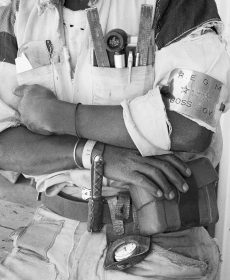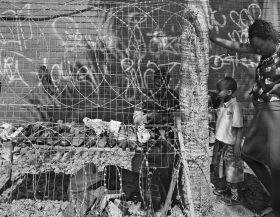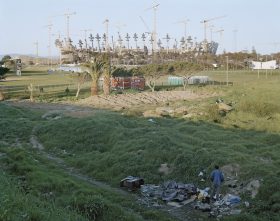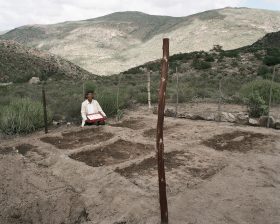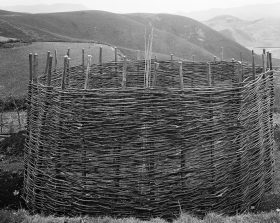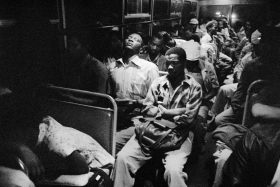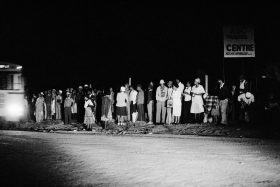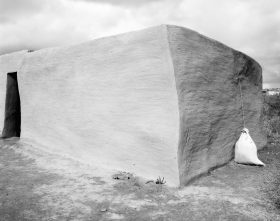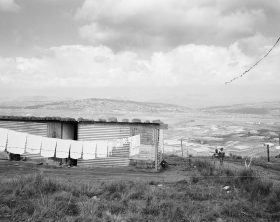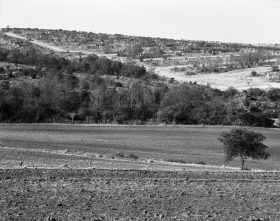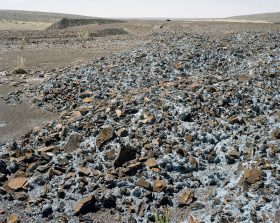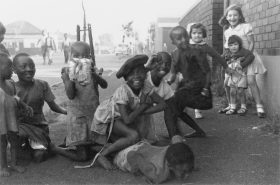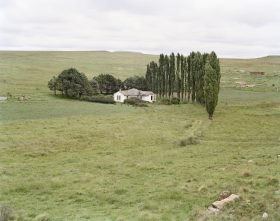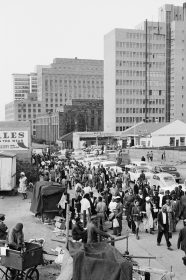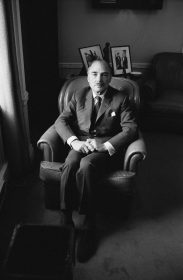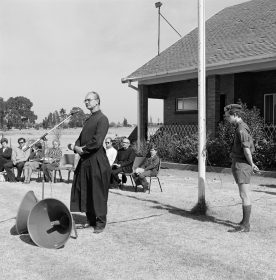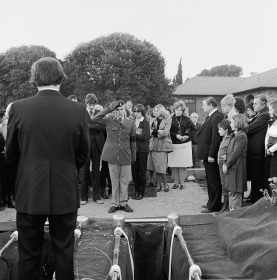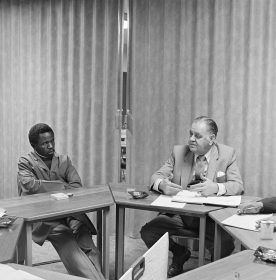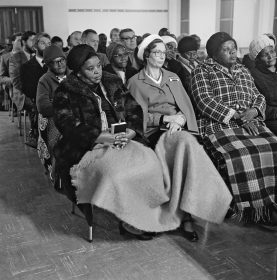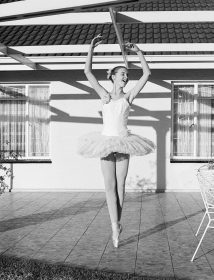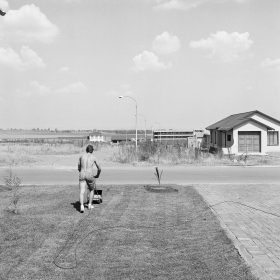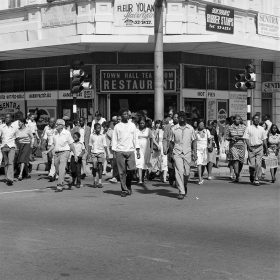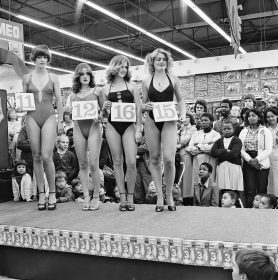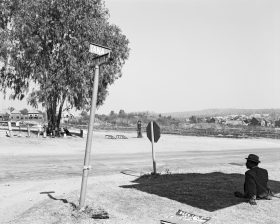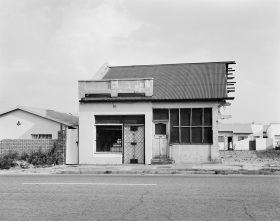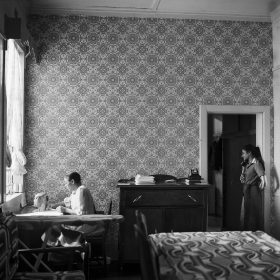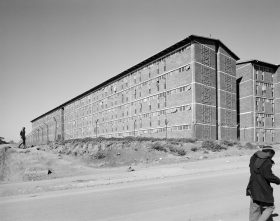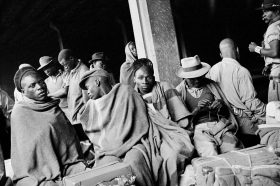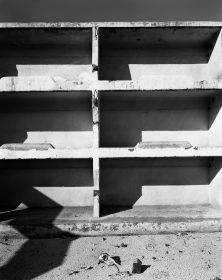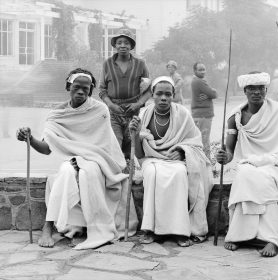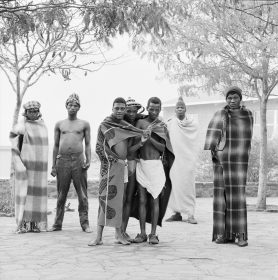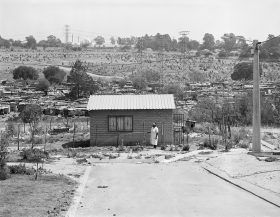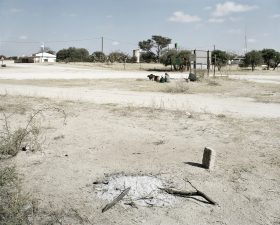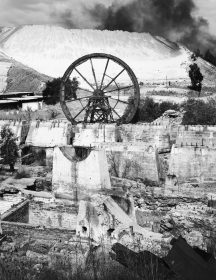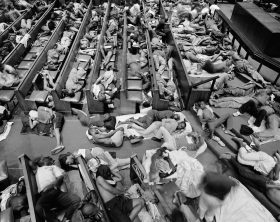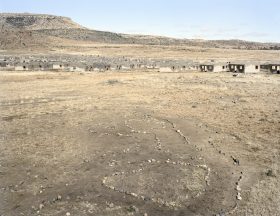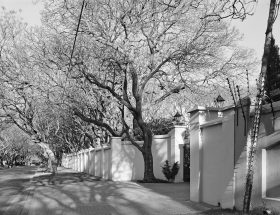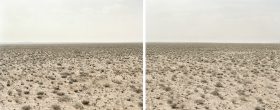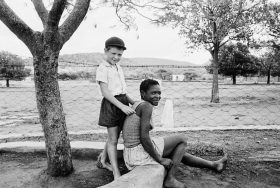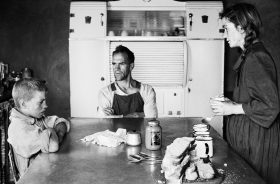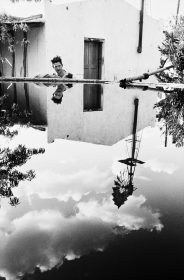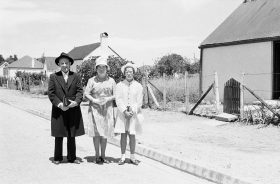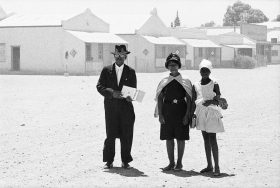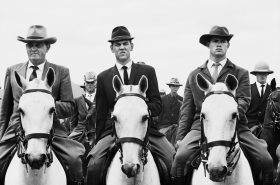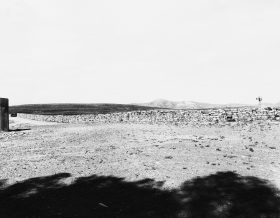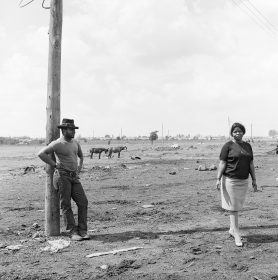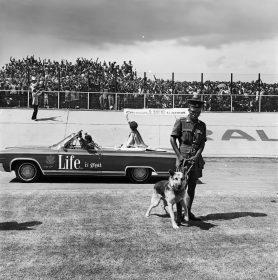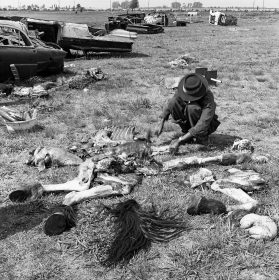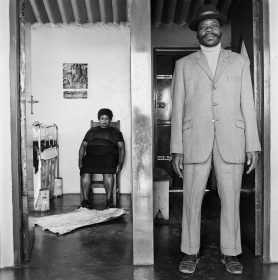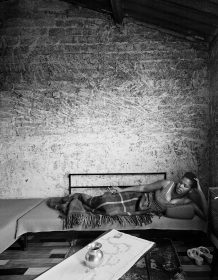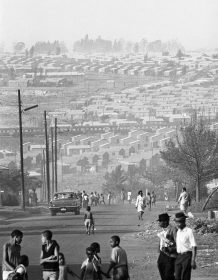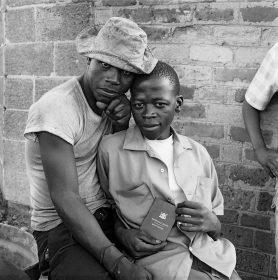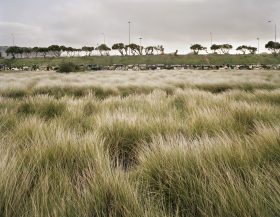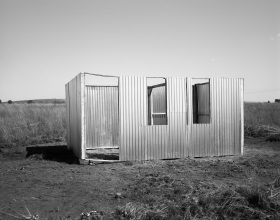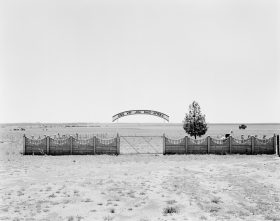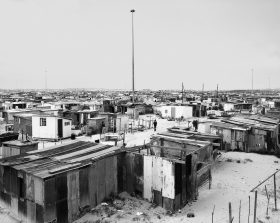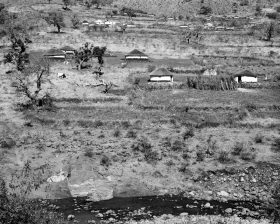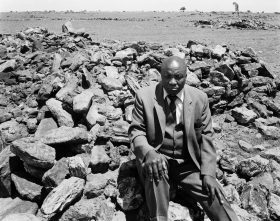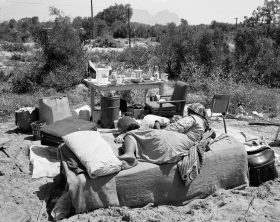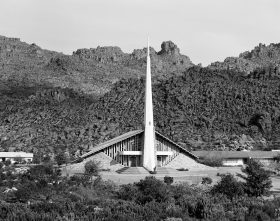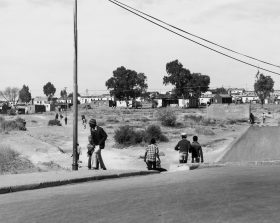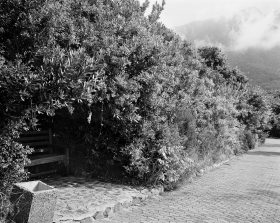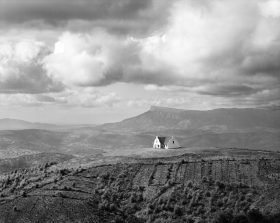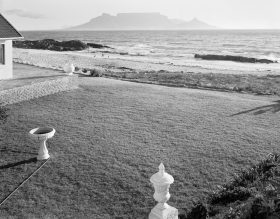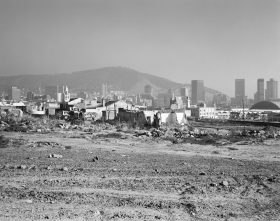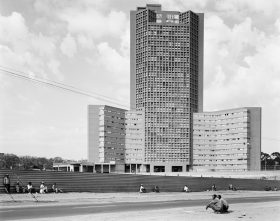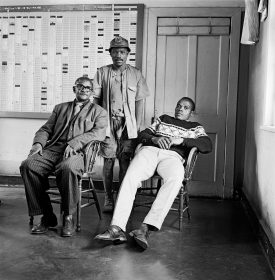Artworks by Goldblatt, David
![Dg 1394]()
"Boss Boy" detail, Battery Reef, Randfontein Estates Gold Mine, Randfontein, Transvaal. 1966
![Dg 1446]()
A shoemaker at work, Raleigh Street, Yeoville. 14 September 2006
![Dg 985]()
A Stadium for the 2010 Soccer World Cup. Green Point, Cape Town. 17 August 2008
![Dg 988]()
Anna Boois, Namaqualand, Northern Cape. 20 September 2003
![Dg 1408 01]()
Bantustans: Framework for a new dwelling, Flagstaff, Transkei. 9 October 1975
![Dg 1408 06]()
Bantustans: Going home: 8:45 pm, Marabastad-Waterval bus; some of these passengers will reach home at 10:00 pm and start the next day at 2:00 am. 1984
![Dg 1408 05]()
Bantustans: Going to work: 2:45 am, the first bus of the day. There being almost no employment opportunities in KwaNdebele, these people travel up to eight hours per day to get to and from work around Pretoria, Mathysloop, KwaNdebele. 1984
![Dg 1408 02]()
Bantustans: House near Phuthaditjhaba, Qwa Qwa. 1 May 1989
![Dg 1408 03]()
Bantustans: Kite flying, near Phuthaditjhaba, Qwa Qwa. 1 May 1989
![Dg 1408 04]()
Bantustans: Landscape with 1500 lavatories, Frankfort, Ciskei. 12 July 1983
![Dg 990]()
Blue asbestos fibres, Owendale Mine, Northern Cape. 26 October 2002
![Dg 1110]()
Children at the border between Pageview (Fietas) and Mayfair, Johannesburg. April 1952
![Dg 986]()
Deserted farmhouse near Molteno. Eastern Cape. 25 February 2006
![Dg 1111]()
Evening exodus from the city. Blacks stream to Westgate station for trains to Soweto; Whites, in their cars, head for the Northern Suburbs, Johannesburg. 1964
![Dg 1396]()
Harry Oppenheimer, chairman of the Anglo American Corporation in his office at the company's headquarters, 44 Main Street, Johannesburg. 1966
![Dg 1414 06]()
In Boksburg: Flag-raising ceremony for Republic Day at Christian Brothers College, Boksburg. 1979-1980
![Dg 1414 07]()
In Boksburg: Funeral with military honours for two boyhood friends who went to school together in Boksburg, were drafted into the same unit of the South African Army, and were killed in the same action against SWAPO on the Namibia-Angola border, Boksburg.
![Dg 1414 04]()
In Boksburg: Meeting of the Worker-Management Liaison Committee of the Colgate-Palmolive Company, Boksburg. 1980
![Dg 1414 08]()
In Boksburg: Members of the Methodist Church meet to find ways of reducing the racial, cultural and class barriers which divide them, Boksburg. 1979–1980
![Dg 1414 03]()
In Boksburg: On the stoep in her new tutu, Boksburg. 1980
![Dg 1414 02]()
In Boksburg: Saturday afternoon in Sunward Park, Boksburg. 1979–1980
![Dg 1414 01]()
In Boksburg: Saturday morning at the corner of Commissioner and Trichardts streets, Boksburg. 1979–1980
![Dg 1414 05]()
In Boksburg: Saturday morning at the Pick 'n Pay hypermarket, semi-final of the Miss Lovely Legs Competition, Boksburg. 1980
![Dg 1441 04]()
Joburg: Domestic worker's afternoon off, Sunninghill, Sandton. 23 July 1999
![Dg 1441 02]()
Joburg: Hassimia Sahib's butchery truncated but still in business after demolition of his neighbour's portion under the Group Areas Act. Whites in residence in their new houses, Fietas. 8 March 1986
![Dg 1441 01]()
Joburg: In the Docrat living room before its destruction under the Group Areas Act, 20th Street, Fietas. 1977
![Dg 1441 03]()
Joburg: Southeast wing of a hostel for Black male workers erected during apartheid as part of a scheme to make Joburg city and suburbs white, Alexandra Township. 1 June 1988
![Dg 1391]()
Migrant mineworkers who had served their contracts on the gold mines and were waiting for a train to take them part-way to their homes in Nyassaland (Malawi), Mayfair railway station, Johannesburg. December 1952
![Dg 1393]()
Miner's bunks in the abandoned Chinese compound, so called because it probably housed indentured Chinese labourer between 1904 and 1910. Before its abandonment in the 1950s, Black miners were accommodated here, Simmer & Jack Gold Mine, Germiston.
![Dg 1810]()
Mineworkers in their hostel, Western Deep Levels, Carletonville
![Dg 1811]()
Mineworkers in their hostel, Western Deep Levels, Carletonville
![Dg 1447]()
Miriam Mazibuko watering her garden, Extension 8, Far East Alexandra Township. 12 September 2006
![Dg 295]()
Mother and Child, Vorstershoop, North West Province. 1 June 2003
![Dg 1392]()
Old mill foundations, tailings wheel and sand dump, Witwatersrand Deep Gold Mine, Germiston. August 1966
![Dg 1448]()
Refugees from Zimbabwe given shelter in the Central Methodist Church, Pritchard Street. 22 March 2009
![Dg 987]()
Remains of households in a children's game called onopopi, and the shells of incomplete houses in a housing scheme that stalled. Kwezinaledi, Lady Grey, Eastern Cape. 5 August 2006
![Dg 1445]()
Second Avenue, Houghton. 26 September 2006
![Dg 296]()
Sheep Farm at Oubip, Between Aggenys and Loop 10, Bushmanland, Northern Cape. 5 June 2004
![Dg 1397 04]()
Some Afrikaners: A farmer's son with his nursemaid, Heimweeberg, Nietverdiend. 1964
![Dg 1397 08]()
Some Afrikaners: A plot-holder, his wife and their eldest son at lunch, Wheatlands, Randfontein. September 1962
![Dg 1397 02]()
Some Afrikaners: A railway shunter who dreamed of a garden without concrete or bricks, watered by this dam on his plot, or small-holding, Koksoord, Randfontein. 1962
![Dg 1397 06]()
Some Afrikaners: An elder of the Dutch Reformed Church walking home with his family after the Sunday service, George. January 1968
![Dg 1397 07]()
Some Afrikaners: An elder of the Dutch Reformed Mission Church walking home with his family after the Sunday service, Carnavon. January 1968
![Dg 1397 05]()
Some Afrikaners: The commando of National Party stalwarts which escorted Prime Minister and National Party leader, Hendrik Verwoerd and his wife, Betsie, to the party's 50th anniversary celebrations at De Wildt, Transvaal. October 1964
![Dg 1397 01]()
Some Afrikaners: The farm Quaggasfontein in the Great Karoo on a summer afternoon. About 250 years ago, after 13 years of work, two slaves are said to have completed the building of this wall which surrounds the farmyard, near Graaff-Reinet. Dec 1966
![Dg 1436 05]()
Soweto: A man and a passing woman, Tladi. 5 November 1972
![Dg 1436 04]()
Soweto: At the Soccer Cup Final, Orlando Stadium. 1972
![Dg 1436 03]()
Soweto: Butchering a coal merchant's horse for its meat after it had been condemned and shot by a municipal inspector, Tladi. November 1972
![Dg 1449]()
Soweto: George and Sarah Manyani, 3153 Emdeni Extension. August 1972
![Dg 1436 02]()
Soweto: Margaret Mcingana at home on a Sunday afternoon, Zola. As Margaret Singana she became a famous singer. She died on 22 April 2000 at the age of 63. October 1970
![Dg 1436 01]()
Soweto: Meadowlands from Mofolo, Soweto, Johannesburg. September 1972
![Dg 1450]()
Soweto: Young men with dompas, White City, Jabavu. November 1972
![Dg 989]()
Squatter camp of foreign nationals between the N1 and railway property at Woodstock. Cape Town. 22 August 2006
![Dg 1422 14]()
Structures: A new shack under construction, Lenasia Extension 9, Lenasia, Johannesburg. 5 May 1990
![Dg 1422 12]()
Structures: Die Heldeakker, The Heroes' Acre: cemetery for white members of the security forces killed in 'The Total Onslaught.' Ventersdorp, Transvaal. 1 November 1986
![Dg 1422 07]()
Structures: Flushing Meadows – so called because it had water-borne sanitation – and lighting masts, Site B, Khayelitsha, Cape Town, Cape. 11 October 1987
![Dg 1451]()
Structures: Homesteads, Manyane, KwaZulu Natal. 28 July 1989
![Dg 1422 09]()
Structures: Luke Kgatitsoe at his house, destroyed by government bulldozers in February 1984. Magopa, Ventersdorp district. 21 October 1986
![Dg 1422 05]()
Structures: Mother and child in their home after the destruction of its shelter by officials of the Western Cape Development Board, Crossroads, Cape Town. 11 October 1986
![Dg 1422 11]()
Structures: Nederduitse Gereformeerde Kerk, inaugurated 31 July 1966, Op-die-Berg, Cape. 23 May 1987
![Dg 1422 10]()
Structures: No Rest Location, formerly New Rest Location renamed by residents because of harassment by the Security Police in the 1980s, Middelburg, Cape. 21 July 1986
![Dg 1422 01]()
Structures: Remnant of a wild almond hedge planted in 1660 to keep the indigenous Khoe out of the first European settlement in South Africa, Kirstenbosch, Cape Town. 16 May 1993
![Dg 1422 08]()
Structures: Speculative investment by a property developer in a house which he claimed was 'authentic Cape Dutch' but which was, in fact, a grossly corrupted version of that form, Agatha, Tzaneen district. 10 April 1989
![Dg 1422 03]()
Structures: Suburban garden, Bloubergstrand and Table Bay, Cape Town ('...the entire coastal belt from Bloubergstrand to Melkbosstrand has been proclaimed a white group area from The Standard Encylopaedia of Southern Africa (1971)'). 9 January 1986
![Dg 1422 04]()
Structures: The destruction of District Six under the Group Areas Act, Cape Town. 5 May 1982
![Dg 1422 13]()
Structures: Unemployed men and Krugerpark government housing scheme for lower and middle class whites. Pretoria, Transvaal. 28 October 1986
![Dg 1395]()
Time-office clerks and a miner, City Deep Gold Mine, Johannesburg. 1966
